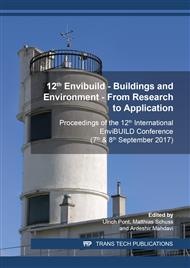[1]
J. Weyr and O. Šikula. Internal Microclimate and Heat Accumulation Assessment in Industrial Building. In: Indoor Climate of Buildings, 2016. pp.179-187.
Google Scholar
[2]
W. Streicher, H. Schnitzer, M. Titz, F. Tazber, R. Heimrath, I. Wetz, S. Hausberger, R. Haas, G. Kalt, A. Damm, K. Steininger and S. Oblasser. Energieautarkie Für Österreich 2050 Innsbruck: , December, 2010. Available via: https://www.klimafonds.gv.at/assets/Uploads/Studien/Energieautarkie205012pt20110308Final.pdf (last accessed: May 2017).
Google Scholar
[3]
M. Wietschel. Energietechnologien 2050 - Schwerpunkte Für Forschung Und Entwicklung. Stuttgart: Fraunhofer-Verl, 2010 ISBN 3839601029.
Google Scholar
[4]
P. Byrne, J. Miriel and Y. Lénat. Modelling and Simulation of a Heat Pump for Simultaneous Heating and Cooling. Building Simulation, Sep, 2012, vol. 5, no. 3. pp.219-232 CrossRef. ISSN 1996-3599. DOI 10.1007/s12273-012-0089-0.
DOI: 10.1007/s12273-012-0089-0
Google Scholar
[5]
W. Stutterecker, T. Schoberer and G. Steindl. Development of a Hardware-in-the-Loop Test Method for Heat Pumps and Chillers. In: Proceedings of REHVA Annual Conference 2015, (2015).
DOI: 10.7250/rehvaconf.2015.017
Google Scholar
[6]
S. Nabi, M. Balike, J. Allen and K. Rzemien. An Overview of Hardware-in-the-Loop Testing Systems at Visteon. Mar 8, (2004).
DOI: 10.4271/2004-01-1240
Google Scholar
[7]
J. Vejlupek, R. Grepl, P. Krejci, F. Lesak and M. Karel. Hardware-in-the-Loop Simulation for Automotive Parking Assistant Control Units. In Proceedings of the 16th International Conference on Mechatronics – Mechatronika 2014. Brno: Brno University of technology, 2014, 2014. s. 325-330. ISBN: 978-80-214-4817-9.
DOI: 10.1109/mechatronika.2014.7018279
Google Scholar
[8]
M. Anderson, M. Buehner, P. Young, D. Hittle, C. Anderson, J. Tu and D. Hodgson. An Experimental System for Advanced Heating, Ventilating and Air Conditioning (HVAC) Control. Energy & Buildings, 2007, vol. 39, no. 2. pp.136-147. Available from: http://www.sciencedirect.com/science/article/pii/S0378778806001587 CrossRef. ISSN 0378-7788. DOI 10.1016/j.enbuild.2006.05.003.
DOI: 10.1016/j.enbuild.2006.05.003
Google Scholar
[9]
R. Lahrech, P. Gruber, P. Riederer, P. Tessier and J.C. Visier. Development of a Testing Method for Control HVAC Systems by Emulation. Energy & Buildings, 2002, vol. 34, no. 9. pp.909-916. Available from: http://www.sciencedirect.com/science/article/pii/S0378778802000671 CrossRef. ISSN 0378-7788. DOI 10.1016/S0378-7788(02)00067-1.
DOI: 10.1016/s0378-7788(02)00067-1
Google Scholar
[10]
P. Haves, A.L. Dexter, D.R. Jorgensen, K.-V. King and G. Geng. Use of a Building Emulator to Develop Techniques for Improved Commissioning and Control of HVAC Systems. ASHRAE Transactions, 1991, vol. 97, no. Pt 1.
Google Scholar
[11]
P. Riederer, V. Partenay and O. Raguideau. Dynamic Test Method for the Determination of the Global Seasonal Performance Factor of Heat Pumps used for Heating, Cooling and Domestic Hot Water Preparation. In: Eleventh International IBPSA Conference, Glasgow, UK, (2009).
Google Scholar
[12]
P. Da Silva and G. Knabe. LabHouse: System Simulation and Emulation within Boiler Development. Building Services Engineering Research and Technology, 2003, vol. 24, no. 4. pp.281-287.
DOI: 10.1191/0143624403bt078oa
Google Scholar
[13]
R. Dott, M.Y. Haller, J. Ruschenburg, F. Ochs and J. Bony. The Reference Framework for System Simulations. International Energy Agency. , 2013. Available via: http://task44.iea-shc.org/data/sites/1/publications/T44A38_Rep_C1_B_ReferenceBuildingDescription_Final_Revised_130906.pdf (last accessed: May 2017).
DOI: 10.18777/ieashc-task44-2013-0006
Google Scholar
[14]
A. De La Cruz, P. Riviere, D. Marchi, O. Cauret and A. Milu Hardware in the Loop Test Bench using Modelica: A Platform to Test and Improve the Control of Heating Systems. Applied Energy, Feb, 2017, vol. 188. pp.107-120 CrossRef. ISSN 0306-2619. DOI 10.1016/j.apenergy.2016.11.092.
DOI: 10.1016/j.apenergy.2016.11.092
Google Scholar
[15]
C. Elliott, V. Vijayakumar, W. Zink and R. Hansen. National Instruments LabVIEW: A Programming Environment for Laboratory Automation and Measurement. JALA: Journal of the Association for Laboratory Automation, 2007, vol. 12, no. 1. pp.17-24.
DOI: 10.1016/j.jala.2006.07.012
Google Scholar
[16]
T. SEL and T. CSTB. Trnsys 16: A Transient System Simulation Program. University of Wisconsin, Madison, USA, (2004).
Google Scholar
[17]
TRNSYS: Transient System Simulation Tool. Interface - Features, 2017. [Accessed 16.04.2017]. Available from:http://www.trnsys.com/features.
Google Scholar
[18]
TRNSYS: Transient System Simulation Tool. Standart Component Library Overview, 2017. [Accessed 16.04.2017]. Available from: www.trnsys.com/assets/docs/03-ComponentLibrary Overview.pdf.
Google Scholar
[19]
B. Delcroix, M. Kummert, A. Daoud and M. Hiller. Conduction Transfer Functions in TRNSYS Multizone Building Model: Current Implementation, Limitations and Possible Improvements. IBPSA-USA Journal, 2012, vol. 5, no. 1. pp.219-226.
DOI: 10.26868/25222708.2013.1192
Google Scholar
[20]
T. Schoberer, J. Weyr, G. Steindl, G. Gortler and W.Stutterecker. Comparison of the energy performance of a heat pump under various conditions by using a hardware-in-the-loop (HIL) test method. In: Envibuild (2017).
DOI: 10.4028/www.scientific.net/amm.887.622
Google Scholar


